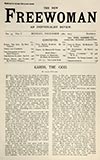How can a literary journal be transparent about the formation of ideas in its own time?
The New Freewoman: An Individualist Review, a modernist literary journal, was the second in a series of three journals that you might consider one project twice renamed. Its titles morphed as the convictions of its editors and backers, as well as the staff themselves, changed and were conveyed in editorials: first it was The Freewoman (1911–1912), then The New Freewoman (1913), then The Egoist (1914–1919).
In his article from 15 Dec. 1913, Benjamin R. Tucker quotes journalist Henry Moret, essentially so that readers can laugh at how the Académie française was rumoured to be considering Moret for membership, perhaps unaware of his anti-statist sympathies. In the quote, Moret sardonically weighs the costs of taxation against “the evils occasioned by the established powers – courts, administration, police etc.” and sides with “the infamous Anarchists.” His focus on financial return rather than, say, the benefits of non-coercive collectivism is surprising today, but it resonated with Tucker, whose own views combined socialism, anarchism, and libertarianism in a way that the common definitions of socialism no longer permit.
In the following issue, the journal would be renamed The Egoist, in deference to the ideas of Max Stirner, whose book The Ego and His Own advanced the individual, free from all duties and obligations, as the only basis of reality. Tucker had in fact published its first English translation in 1907 (the original German dates to 1845) and the book’s emphasis on strict personal liberty as the bedrock of anarchy, understood to be the dissolution of any coercive authority, connected Tucker, Moret, and the journal’s editor Dora Marsden.
Tracing these correspondences is an encounter with mess – overlapping influences and affiliations, changing orientations, and apparent contradictions that give a sense of how the meanings of certain political terms have closed substantially over a century. Considering this issue of The New Freewoman sparked ideas for me about how a publication can foreground the realities of thinking in an extended network, and surface the messy shape that arguably underlies any project or community.
Superficially, its contents have a social quality: over a dozen contributors report on developments abroad, introduce extracts, review, serialise their novels for implied regular readers, and repeat hearsay. There is a sense of gossip, naming names, disagreement and response through letters to the editors. Updates from France and its revues were important, and some poems were published in French (Tucker begins his article ‘Of late there is much talk in France…’).
If Marsden and her colleagues wished to cast off authority over the individual, they managed to give the impression that such a world would privilege conversation, publication, and circulation as paramount to free association and collectivism. Lengthy editorials track the changes in journal title and orientation, responding partly to feedback from contributors themselves, as another among many forms of community-making in print.
The retrospective view often collapses the complexities of intellectual history. Attempts at faithful reconstruction are like holding sand in your hands: just as you grasp the constellation of people, ideas, and projects, the substance gathered slips through your fingers in new directions. The boundaries of a journal issue can construct a welcome snapshot in time.




